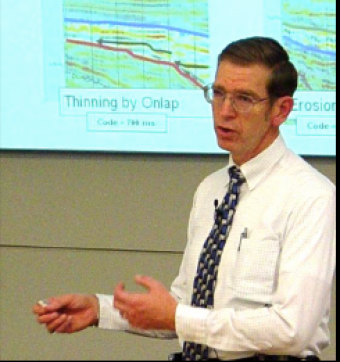The lesson uses the basics seismic reflection principles, and allows the student to apply them to interpret a geologic framework, conduct a data analysis, prospect for hydrocarbons, and then assess whether the basin should be bid on and provide an economic analysis.
This lesson can be divided into three (3) segments, which includes a review of the previous lecture material and exercises based on hydrocarbon seal and migration, introduce the lecture material presented here, and then introduce the exercise material presented here. The review of the first part of the previous exercise should take about ten (10) minutes and has nine (9) slides, while the review of the second part of the previous exercise also takes about ten (10) minutes and contains eight (8) slides. The lecture material will take about forty (40) minutes to cover and contains thirty-five (35) slides. The introduction to the exercise presented here takes about twelve (12) minutes to explain and contains fourteen (14) slides.
The exercise will take time for the students to loop tie the uninterpreted lines. The lecture explains the general procedure of loop tying, and the introduction to the exercise gives the students the background they need for the particular data set. The seismic data presented here are from the Gippsland Basin, SE Australia. The other task is to locate large anticlines and spot them on the basemap. These are the potential hydrocarbon traps that they will consider in a lease sale. Students can use shot points on the seismic lines or relative positions between crossing lines to mark the positions of anticlines. Note that there are is no solution to the exercise, but the students will use their results as input to the following exercise.
It is good to have the students work in teams of 2 or 3. Much of the work in oil companies is done via teams. However, you have to access how practical it is for your students to find a meeting time and place for working exercises as teams outside class hours. If a lot of your students commute and/or have jobs, it may be best for them to work independently.
At this point in the lecture series, students should now have a firm foundation in seismic reflection. After this lecture, students should be able to:

This course, based on teaching material from Dr. Fred Schroeder (formerly of Exxon/ExxonMobil), reflects on the geology and geophysics basics for the petroleum industry. General geology and basic geophysics are not required, but helpful with the material.